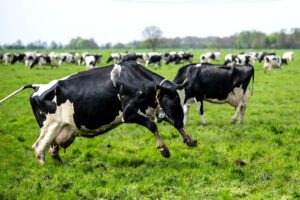
The technology
Sperms, or the reproductive cells in the semen that lead to the fertilisation of an egg allowing conception, contain both X and Y chromosomes. When the egg, which contains X chromosome, receives another X chromosome from the sperm, a female is born. Thus conventional artificial insemination offers a 50 per cent chance of conceiving a male or female. Both the patented sexed semen technologies work by following a basic method of separating the X and Y chromosomes present in the sperm and use a special dye that colours or stains the chromosomes, which is then subjected to a UV (ultraviolet) laser beam. The dye and the blue fluorescence highlights the chromosomes so scientists can differentiate and sort them. The Y chromosomes are then inactivated.
Following this, ABS uses a technology in which the inactivated Y chromosomes are collected in the straw along with the active X. In the technology used by Sexing Technologies, the chromosomes are passed through an electromagnetic field and are separated using variations in their surface charges. The inactivated Y chromosomes are then discarded. In both the technologies, the semen, which contains over 90 per cent more X chromosome-based sperms, is collected in a straw, stored at -196°C and then used for artificial insemination as and when required. “Each straw contains 2.6 million sperms and the entire process of sorting takes about six hours,” informs Sagar Saraswat, laboratory manager of Babugarh DFS production centre. K K Tyagi, deputy director at the centre, says the aim of promoting sexed semen in India is threefold: to increase cattle produc-tivity, reduce unnecessary expenditure of farmers and lower stray cattle numbers.
The average cost of sexed semen in India varies from Rs 1,000 to Rs 2,200 per insemination, depending on factors like breed and pedigree of the bull used for producing the semen, scientists tell DTE. But to promote its adoption among farmers, various state governments are offering it at a subsidised rates.
The Uttar Pradesh government, for instance, purchases the sexed semen from ABS at Rs 766 per straw and sells to farmers at a subsidised cost of Rs 100. The Rs 666 subsidy is borne by both the Union and state governments in a 50:50 ratio. Haryana, till last year, provided one semen straw at a subsidised rate of Rs 200 to farmers, informs a doctor at a government veterinary hospital in Hisar. By comparison, conventional semen costs farmers Rs 30, he says.
To bring down production cost by developing indigenous technologies, the Union government in 2024 roped in apex institutes. The list includes Indian Institute of Technology (IIT), Delhi, IIT, Madras, Lala Lajpat Rai University of Veterinary and Animal Sciences (LUVAS) in Hisar, Haryana, and the Indian Veterinary Research Institute under the Indian Council of Agricultural Research (ICAR-IVRI). Under one of the projects, scientists have been asked to develop “labelled-free technology”, that would produce sexed semen without using dye.
“Scientists have raised concerns that the use of dye could potentially damage the DNA, and thus in the long run the technology could harm the genetics of the animal,” says Aman Kumar, senior scientist, LUVAS, Hisar. Kumar is involved in the project of developing labelled-free technology that will be ready by October 2026.




